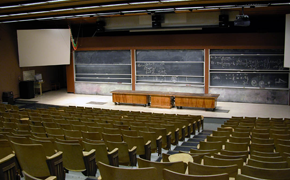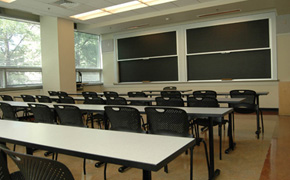This Course at MIT pages are part of the OCW Educator initiative, which seeks to enhance the value of OCW for educators.
Course Overview
This page focuses on the course 7.013 Introduction to Biology as it was taught by Professor Hazel Sive, Professor Tyler Jacks, and Dr. Diviya Sinha in Spring 2013.
At MIT, all undergraduate students are required to take introductory biology. 7.013 is one of the five versions of introductory biology that satisfy this requirement. All five versions cover a common core of material (biochemistry, genetics, molecular biology, cell biology, and recombinant DNA technology). Each class has a particular focus; 7.013's special focus topics are genomic approaches to human disorders, neuroscience, development, and repair.
Course Outcomes
Course Goals for Students
- To be curious about biology and understand that biology is fascinating
- To understand that the life sciences are huge and interface with almost every other discipline
- To understand that life sciences and biology are studied in a rigorous way
- To understand that biology is all about problem solving and applying information, not just learning information
- To be able to make hypotheses and solve problems in biology
Possibilities for Further Study and Future Careers
Students from this course go into many different majors, but it is estimated that at least half of them end up majoring in an area with a life sciences focus and/or conducting undergraduate research in a life sciences based lab. There are 13 majors based in the life sciences at MIT, and almost half of on-campus research is life sciences based.
Biology is a rigorous problem solving discipline; in fact, biology is all about using information to solve problems. ... It's very challenging for the students.
—Prof. Sive
Below, Professor Hazel Sive, one of the two professors for 7.013 Introductory Biology, describes various aspects of how she teaches the course.
- Teaching Students to Solve Problems
- Interacting with Students in a Large Class
- Anatomy of a Lecture
- Preparing and Updating Lectures
- Interface with 7.00x
Below, Dr. Diviya Sinha, course instructor for 7.013 Introductory Biology, describes various aspects of how she prepares materials for and coordinates the course.
Curriculum Information
Prerequisites
None
Requirements Satisfied
Offered
Every spring semester

Enrollment
Typically around 300-400 students per year; roughly one third of MIT undergraduate students take 7.013 before they graduate.
Breakdown by Year
Primarily freshman; some sophomores, juniors, seniors, and graduate students.
Breakdown by Major
All majors, since all MIT undergraduates are required to take one of the five introductory biology courses. The only alternative to taking introductory biology is passing the biology Advanced Standing Exam, which is typically passed by less than 5 percent of each year's incoming class. The Advanced Placement® biology exam is not accepted for this requirement.
Typical Student Background
Student background spans an enormous range. Some students have substantial biology background, having taken AP® biology or even having conducted biology research as high school students. Others, especially international students, might not have taken biology since elementary or middle school.
During an average week, students were expected to spend 12 hours on the course, roughly divided as follows:
Lecture
- Three lectures per week, each lasting 50 minutes
- Attended by all students
- Lectures given by Prof. Hazel Sive or Prof. Tyler Jacks
- Covered all required content for the course
- Included use of chalkboard, slides, handouts, demonstrations, and mini quizzes
Recitation
- Two recitations per week, each lasting 50 minutes
- 20-25 students per recitation
- Taught by teaching assistants (graduate students or advanced undergraduate students)
- Included review of lecture material and work on recitation problems
Out of Class
- Seven problem sets
- Readings
- Preparation for exams
- Optional office hours
- Optional, free one-on-one tutoring
Semester Breakdown
| WEEK | M | T | W | Th | F |
|---|---|---|---|---|---|
| 1 |  |  |  |  |  |
| 2 |  |  |  |  |  |
| 3 |  |  |  |  |  |
| 4 |  |  |  |  |  |
| 5 |  |  |  |  |  |
| 6 |  |  |  |  |  |
| 7 |  |  |  |  |  |
| 8 |  |  |  |  |  |
| 9 |  |  |  |  |  |
| 10 |  |  |  |  |  |
| 11 |  |  |  |  |  |
| 12 |  |  |  |  |  |
| 13 |  |  |  |  |  |
| 14 |  |  |  |  |  |
| 15 |  |  |  |  |  |
| 16 |  |  |  |  |  |
 No classes throughout MIT
No classes throughout MIT Lecture
Lecture Exam
Exam No class session scheduled
No class session scheduled Recitation
Recitation Problem set due
Problem set due7.013 has a large course staff to meet the needs of its ~400 students. The roles of the course staff are briefly outlined below.
Professors (Prof. Hazel Sive and Prof. Tyler Jacks)
- Design and structure the course; define and organize the course syllabus
- Prepare and deliver lectures, with roughly half of the lectures given by each professor
- Interact with individual students via e-mail and substantial office hours
- Work with the course instructor to create problem sets, exams, and other course materials
Course Instructor (Dr. Diviya Sinha)
- Selects, trains, organizes, and oversees teaching assistants (TAs), tutors, and graders; treads the gaps between different aspects of the course and facilitates contact among TAs, tutors, graders, professors, and students as necessary
- Creates problem sets, exams, recitation materials, and other course materials in consultation with the course professors
- Organizes recitation sections, grading, and exam sessions
- Teaches two recitation sections
- Interacts with individual students via e-mail, weekly office hours and tutoring sessions, recitations, and the course's online forum
Teaching Assistants (8-12 graduate students or advanced undergraduate students)
- Teach one or two recitation sections with 20-25 students; each recitation section meets twice a week
- Assist in preparing for recitations and revising problem sets and solution keys
- Grade problem sets and exams
- Refer students for tutoring
- Hold weekly office hours
Tutors (about 25 undergraduate students)
- Provide free, one-on-one tutoring service for any interested student; funded by the department


 Room 1 of 2
Room 1 of 2 
